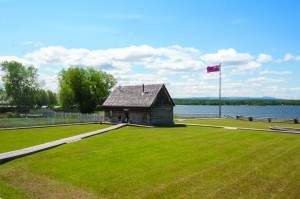As Canadians mark the 150th anniversary of Confederation, it is also a time to celebrate the 100th anniversary of national historic sites.

Parks Canada offers visitors 171 remarkable and inspiring places where they can walk in the footsteps of history, and explore our national heritage. From lighthouses to battlefields, historic districts to cultural landscapes, there is an amazing array of places to discover. The scope of national historic commemoration has also grown to encompass historic events and people. Canada’s list of national designations continues to grow, reflecting the rich heritage of our country and providing opportunities for Canadians to learn more about our diversity, including the history, cultures, and contributions of Indigenous Peoples.
Jasper National Park has four national historic sites within its boundaries and the field unit also includes Fort St. James National Historic Site in British Columbia.
Fort St. James
In 1805 and 1806, the North West Company constructed the first two permanent fur trade posts west of the Rocky Mountains. The second, Fort St. James, became the centre of the northern fur trade district, known as New Caledonia. Although today it is restored to a single year in time, 1896, the story you will hear spans about 146 years, starting with the arrival of the fur traders and ending in 1952, when the Hudson’s Bay Company closed shop on the original site.
The Athabasca Pass was a major fur trade transportation route. In January 1811, David Thompson, guided by Thomas the Iroquois, was the first white man to cross the Rockies through this pass. He then led his party down the Wood River to a place on the Columbia River later called Boat Encampment. Governor George Simpson subsequently named the small lake at the top of the pass “the Committee’s Punch Bowl” – a reference to the London Committee of the Hudson’s Bay Company. For almost half a century, the Athabasca Pass was part of the main fur trade route between Canada and the Oregon country. The viewpoint is located about 25 km south of town on the Icefields Parkway.
Built in 1913, the information centre is one of the finest and most influential examples of the rustic design in Canada’s national parks. Designed by A.M. Calderon and completed in 1914, it introduced a building tradition based on the use of local construction materials, in this case cobblestone and timber. The facility originally housed park administration offices, a museum, and living quarters for the park superintendent. As the first major building in the townsite, it helped to define the character of Jasper’s early development and provided a conspicuous landmark that greeted park visitors upon their arrival by train.
This pass was referred to by early fur traders as “leather pass,” a major transportation route through the Rocky Mountains. This pass was used for brief periods from the mid-1820s to the early 1850s by the Hudson’s Bay Company, principally to transport leather, especially moosehides, from the Saskatchewan District to its posts in New Caledonia. It derives its name from Pierre Bostonais, called Tête Jaune, an Iroquois freeman active here in the early 19th century. Originally chosen by Sanford Fleming for the Canadian Pacific Railway, the Yellowhead Pass eventually became part of the Grand Trunk Pacific and Canadian Northern routes (now the CNR), and later still, a major highway crossing of the Rocky Mountains.
Jasper House is the archaeological remains of an 1829 fur trade post. In 1813 the North West Company built Rocky Mountain House on Brûlé Lake as a provision depot for brigades crossing the Athabasca Pass to the Pacific. When Jasper Hawes took command of the post in 1817 it became known as “Jasper’s House” to avoid confusion with Rocky Mountain House on the Saskatchewan. The Hudson’s Bay Company moved Jasper House upriver to this site in 1829, but by mid-century decreasing traffic over the pass sent the post into decline. When Paul Kane was here in 1846 this was a remote outpost commanded by Colin Fraser, George Simpson’s former piper. A half-century later Jasper House was finally closed.
Parks Canada Special to the 51����
